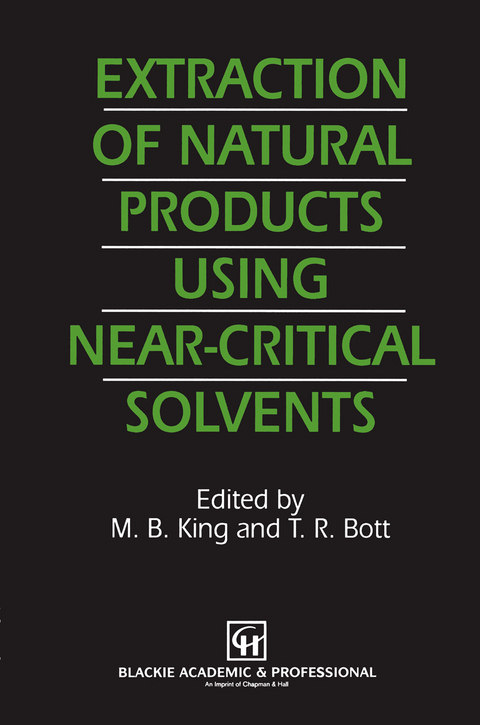
Extraction of Natural Products Using Near-Critical Solvents
Springer (Verlag)
978-94-010-4947-4 (ISBN)
1 Introduction.- 1.1 Compressed and liquefied gases as solvents: the commercial applications.- 1.2 The scope of the book.- 1.3 Range of solvent conditions regarded as ‘near-critical’.- 1.4 Range of available solvents.- 1.5 Range of components present in natural products: typical phase behaviour with near-critical carbon dioxide and similar near-critical solvents.- 1.6 Role of solvent density.- 1.7 Possible and actual process layouts.- 1.8 Advantages in use of near-critical solvents: future prospects.- Appendix: Some historical notes.- References.- 2 Food legislation and the scope for increased use of near-critical fluid extraction operations in the food, flavouring and pharmaceutical industries.- 2.1 Introduction.- 2.2 Solvent extraction of foodstuffs and flavourings: legal restrictions on solvents used and residual solvent levels.- 2.3 Widening the choice of extraction solvent: compressed and liquefied gases as solvents: economic and other problems in their use.- 2.4 Use of carbon dioxide for dense gas extractions: ‘rule of thumb’ solubility rules.- 2.5 Actual and proposed applications of extractions using dense CO2: tabular review of the literature.- References.- 3 Other uses for near-critical solvents: chemical reaction and recrystallisation in near-critical solvents.- 3.1 Chemical reaction in near-critical solvents.- 3.2 Recrystallisation in near-critical solvents.- References.- 4 Commercial scale extraction of alpha acids and hop oils with compressed CO2.- 4.1 Introduction, composition and brewing value of hops.- 4.2 Convenience of hop extracts.- 4.3 Advantages of compressed CO2 over conventional organic solvents for the extraction of hops: extraction plant using this solvent.- 4.4 Conclusions.- References.- 5 Commercial scale decaffeination of coffee andtea using supercritical CO2.- 5.1 Introduction: the extent of coffee and tea production worldwide and the need for decaffeination.- 5.2 Present-day demand for decaffeinated products and trends in the market.- 5.3 Brief description of the currently used processes for decaffeination and their history.- 5.4 Decaffeination with compressed CO2.- 5.5 The patent literature for decaffeination processes.- 5.6 Comparison of economic aspects of the CO2-based and ethylacetate-based decaffeination processes.- 5.7 Technical aspects of plant design.- 5.8 Conclusions.- References.- 6 Extraction of flavours and fragrances with compressed CO2.- 6.1 Introduction.- 6.2 The properties of CO2 as an extraction solvent.- 6.3 The raw materials.- 6.4 Equipment.- 6.5 Commercial use of CO2 extracts since 1982.- 6.6 Conclusions.- Appendix: CO2-extracted flavour and fragrance ingredients.- References.- 7 Physico-chemical data required for the design of near-critical fluid extraction process.- 7.1 The need for physico-chemical data.- 7.2 Phase equilibria.- 7.3 Mass transfer rate parameters.- Appendix: The fluid mass balance equations.- References.- 8 Design and operation of the pressure vessels used in near-critical extraction processes.- 8.1 Introduction.- 8.2 Classification of pressure vessels.- 8.3 Vessel design.- 8.4 Operation of the pressure vessels in a near-critical extraction plant.- 8.5 Design and development of equipment for the continuous extraction of solids.- References.- 9 Pumps and compressors for supercritical extraction.- 9.1 Introduction.- 9.2 Process requirements.- 9.3 Pumps for liquids.- 9.4 Compressors for gas recovery.- References.- 10 Estimation of separation cost.- 10.1 Introduction.- 10.2 Energy and economic assessment of near-critical extraction processes.- 10.3 Extractionwith a marginally subcritical solvent.- 10.4 Extraction with supercritical solvent.- 10.5 Energy and other costs in some typical cases.- 10.6 Example of preliminary costing.- References.
| Zusatzinfo | XI, 325 p. |
|---|---|
| Verlagsort | Dordrecht |
| Sprache | englisch |
| Maße | 155 x 235 mm |
| Themenwelt | Naturwissenschaften ► Biologie ► Genetik / Molekularbiologie |
| Naturwissenschaften ► Chemie | |
| Technik ► Maschinenbau | |
| Technik ► Umwelttechnik / Biotechnologie | |
| ISBN-10 | 94-010-4947-5 / 9401049475 |
| ISBN-13 | 978-94-010-4947-4 / 9789401049474 |
| Zustand | Neuware |
| Haben Sie eine Frage zum Produkt? |
aus dem Bereich


